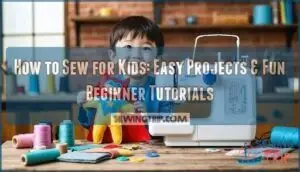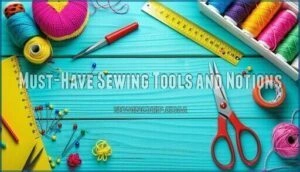This site is supported by our readers. We may earn a commission, at no cost to you, if you purchase through links.
 Teaching your kids how to sew for kids transforms ordinary afternoons into magical moments of creation.
Teaching your kids how to sew for kids transforms ordinary afternoons into magical moments of creation.
Start with simple hand-sewing projects using felt and cotton fabrics, which forgive mistakes and handle easily. You’ll need child-safe scissors, blunt needles, and colorful thread to spark their imagination.
Begin with running stitches on practice fabric before tackling fun projects like felt animals or superhero capes.
Machine sewing works great for older kids who’ve mastered hand techniques. The key is letting them work at their own pace while celebrating every crooked seam and wonky button.
Remember, those "imperfect" creations often become their most treasured possessions, and yours too.
Table Of Contents
Key Takeaways
- Start with hand sewing before machines – You’ll build better finger control and thread understanding with simple running stitches on felt fabric, which doesn’t fray and forgives mistakes easily.
- Choose quality, child-safe tools – You’ll want sharp fabric scissors, blunt needles, and colorful thread rather than cheap toy versions that frustrate kids and create poor results.
- Let kids work at their own pace – You’ll build confidence by celebrating every crooked seam and allowing children to choose their own fabrics and colors for personal creative expression.
- Focus on simple, practical projects – You’ll keep kids engaged with quick wins like felt animals, tooth fairy pillows, or superhero capes that they can actually use and treasure.
What is Sewing? Meaning and History
You’ve probably seen your grandma sewing a button or watched someone mend a torn shirt, but sewing is much more than just fixing things.
Sewing means joining pieces of fabric together with stitches, and it’s been around since before the 12th century when people first started using the word from Old English, which is a complete concept that has been passed down through generations.
Sewing connects us to centuries of human creativity and practical wisdom
Definition and Etymology of Sewing
Sewing’s word history traces back over 900 years to Old English "sīwian," meaning to unite fabric with stitches.
This Etymology reveals sewing’s ancient roots, connecting to Latin "suere" and Germanic languages. The Sew Definition encompasses joining materials through needle-and-thread techniques.
Understanding these Sewing Origins helps you appreciate this timeless craft that’s perfect for teaching kids foundational skills.
The art of sewing involves various sewing methods that have evolved over time, shaping the craft into what it’s today.
Historical Origins and Word Usage
Looking back through time reveals fascinating sewing history and etymology.
Ancient civilizations mastered textiles thousands of years ago, creating the foundation for today’s craft.
The word "sewing" comes from Old English "sīwian," connecting to Latin "suere," showing how deeply woven sewing is into human culture.
These word origins tell us that people have been stitching since before the 12th century, making sewing one of humanity’s oldest skills.
Common Contexts and Examples in Daily Life
From mending tears in your child’s favorite shirt to creating handmade gifts, sewing touches everyday life constantly.
You’ll find Sewing Basics helpful for Practical Uses like hemming pants or fixing backpack straps.
Kids Sewing Projects build confidence while teaching Hand Sewing Techniques.
The Sewing Community offers support through Sewing Classes for Kids, while quality Fabric Choices guarantee lasting results.
These Daily Applications make sewing invaluable.
Essential Tools and Materials for Kids
Getting the right tools makes sewing with kids much easier and way more fun.
You’ll want to focus on safety, quality, and child-friendly options that actually work well instead of cheap toys that frustrate everyone.
Choosing The Right Sewing Machine for Beginners
Finding the right machine for your child doesn’t have to break the bank or overwhelm your senses.
Focus on safety features like finger guards and adjustable sewing speed controls that prevent accidents.
Look for machines with 10-30 stitch options—enough variety without confusion.
Consider budget-friendly models like the Brother CS7000X or Singer Simple, which offer excellent fabric compatibility and durability for growing skills.
When selecting a machine, consider the key features of kids sewing machines to guarantee a good learning experience.
Must-Have Sewing Tools and Notions
Your child’s sewing journey becomes smoother with quality tools that won’t frustrate little hands.
Sharp fabric scissors, smooth pins, and various sewing needles form the foundation.
Add measuring tools like tape measures and rulers for accuracy.
Don’t forget a seam ripper for mistakes—they happen!
Quality sewing kits often include these basics.
Using flexible tape measures guarantees accurate body measurements.
Remember, good scissors and the right thread make all the difference in keeping kids engaged and excited.
Best Fabrics and Threads for Kids’ Projects
Now that you’ve got the right tools, fabric selection becomes your secret weapon in sewing for kids.
Smart fabric choices make projects easier and more enjoyable for young hands to manage.
Cotton fabrics shine as the gold standard for beginner sewing. Here’s what makes them perfect:
- Cotton and cotton blends offer softness, breathability, and easy washing – plus they’re forgiving when kids make mistakes
- Felt remains king for hand sewing since it won’t fray and handles large needles beautifully
- Quality thread colors in cotton or poly-cotton give kids durability and endless creative options
Kid friendly materials like lightweight muslin work great for summer projects, while jersey knits stretch with active play.
Choose fabric texture that feels good to touch – soft materials keep kids engaged longer and build positive sewing skills from the start.
For a great sewing experience, consider using easy to sew fabrics to make the process enjoyable for kids.
Safety Tips for Kids Using Sewing Tools
Sharp needles and scissors demand respect—no running or waving tools around.
Treat sharp tools like your best friend’s feelings—with complete care and attention
Keep machine guards in place and unplug when threading. Store sharp objects safely after each sewing session.
Teach proper tool handling techniques from day one. Watch for loose fabric that might catch or tangle.
Supervise closely during initial sewing classes for kids, gradually building independence as skills develop through consistent practice. When selecting scissors, consider using kid friendly scissors to guarantee safety.
Teaching Kids Basic Sewing Skills
Teaching your child to sew starts with mastering a few simple hand-sewing techniques that build confidence and coordination.
You’ll want to begin with basic skills like threading needles and practicing straight stitches before moving on to fun projects that spark their creativity.
Hand Sewing Vs. Machine Sewing for Children
You’ll want to keep in mind both hand sewing and machine basics when teaching kids.
Hand sewing offers better sewing safety for younger children, while machines work well for older kids ready for advanced kid projects.
Here’s what makes each approach special for sewing with kids:
- Hand sewing builds patience – Kids develop fine motor skills stitch by stitch
- Machine sewing sparks excitement – The speed creates instant gratification
- Both methods teach fabric choice – Understanding materials becomes second nature
- Each offers unique sewing tips – Different techniques suit different learning styles
Threading a Needle and Tying Knots
Teaching kids needle threading starts with a clean thread cut—no fraying ends.
Show them the "loop and pull" method for secure knots. Quality sewing needles with larger eyes make threading easier for small fingers.
These fundamental hand sewing skills build confidence before tackling actual stitches. Master thread types and knot tying first—it’s your foundation for all beginner sewing adventures ahead, with a strong emphasis on complete concepts.
Practicing Running, Backstitch, and Straight Stitches
Once you’ve mastered needle threading and knot tying, it’s time for stitch practice! These three sewing basics form the foundation of all hand sewing for kids.
Focus on needle control and keep thread tension loose but steady.
- Running Stitch: Move needle up and down in straight lines, creating even spaces between stitches
- Backstitch: Overlap each stitch by going backward, then forward for strong seams
- Straight Stitch: Practice perfect lines on felt fabric choice – it won’t fray or shift
- Speed Control: Start slow with sewing techniques, building muscle memory before increasing pace
Remember, kids sewing projects improve with regular practice sessions!
By following proper teaching kids techniques, young sewers can develop essential skills and build confidence in their abilities.
Using Worksheets and Sewing Mazes for Skill Building
Sewing Games and Maze Patterns transform practice into play.
These Skill Builders help kids master hand-eye coordination through engaging Sewing Drills.
Fabric Puzzles guide young hands along marked lines, building confidence naturally.
Sewing Books for Children often include these activities, making Sewing 101 concepts stick.
Whether you’re running Sewing Classes for Kids or exploring Kids Sewing Projects at home, worksheets keep little fingers busy while developing essential skills.
Easy and Fun Sewing Projects for Kids
Looking for projects that’ll spark your child’s creativity? Kids Sewing Projects come alive when you match the right craft to their skill level. Start with simple felt creatures using Kid Sewing Kits that include pre-cut shapes and child-safe needles.
These kits take the guesswork out of Fabric Choices while teaching basic stitches. Try making tooth fairy pillows or bandana blankets—they’re perfect first wins.
Sewing Games like creating superhero capes or pet toys keep little hands engaged. For machine beginners, drawstring backpacks offer practical Project Ideas that kids actually use.
Craft Safety means starting with felt since it won’t fray, then progressing to cotton fabrics. Sewing Books for Children provide templates and inspiration, while local Sewing Classes for Kids offer hands-on guidance.
Remember, Sewing with Kids works best when projects feel like play, not work. Choose colorful threads, fun patterns, and projects they can finish in one sitting to keep enthusiasm high.
Tips for a Positive Sewing Experience
Creating a positive sewing experience starts with the right approach and mindset.
You’ll set your child up for success by using quality tools, maintaining patience, and celebrating every small victory along the way.
Letting Kids Use Real, Quality Tools
Don’t hold back in regards to quality sewing tools for your little ones. Kid-friendly doesn’t mean cheap or flimsy. Quality machines and proper sewing aids help children develop confidence while maintaining tool safety.
Here’s why real tools matter for kids sewing projects:
- Sharp scissors cut cleanly – Dull tools frustrate kids and create messy edges
- Child ergonomics prevent fatigue – Properly sized tools fit small hands better
- Quality machines reduce tangles – Fewer jams mean more successful sewing classes for kids
Starting Early and Practicing Regularly
Early introduction pays dividends—children starting sewing before age seven show 28% better fine motor skills.
Weekly practice sessions create sewing habits that boost hand-eye coordination by 25%.
Set achievable sewing goals like mastering basic stitches within two months through regular projects.
Daily stitches, even for ten minutes, cement skills faster than sporadic learning sessions.
This consistent approach transforms sewing for kids from frustrating struggle into joyful mastery, making it essential to establish a routine that promotes consistent approach and helps in achieving fine motor skills.
Allowing Kids to Work at Their Own Pace
Every child learns to sew at their own unique rhythm, and that’s perfectly normal.
Don’t rush your little one through sewing techniques or compare their progress to others in sewing classes.
Some kids need extra time mastering their sewing kit, while others zoom ahead, and it’s essential to respect different learning styles and creative freedom to ensure a positive experience.
This kid-friendly pace setting creates positive sewing for kids experiences that last a lifetime.
Building Confidence Through Success and Creativity
Success breeds success, and nothing builds confidence like seeing your own creations come to life.
When kids master basic stitches in Sewing Classes, they gain Creative Freedom that transforms simple fabric into treasured keepsakes. These Confidence Boosters through Skill Mastery make Learn To Sew adventures feel like magic, turning every project into Artistic Expression.
- Celebrate every finished project – Display their work proudly, even if stitches are wobbly
- Let them pick their own fabrics and colors – Personal choices fuel Sewing Motivation
- Start with quick wins – Simple bookmarks or coasters build momentum for bigger dreams
Frequently Asked Questions (FAQs)
What are some appropriate sewing tools for kids to use?
Like teaching someone to ride a bike with training wheels, you’ll want kid-safe needles, fabric scissors, colorful thread, measuring tape, pins or clips, and felt fabric that won’t fray easily.
How can I encourage my child to continue sewing after completing a project?
Celebrate their finished project with genuine excitement! Display their creation prominently, help them share photos with family, and immediately start brainstorming their next fun project together.
Are there any safety precautions I should take when teaching kids to sew?
Better safe than sorry" in the case of sharp tools and enthusiastic fingers.
You’ll want kid-friendly needles, supervise scissor use closely, and choose felt fabric that won’t fray.
Keep first-aid supplies nearby and teach proper handling techniques early.
What are some age-appropriate sewing projects for beginners?
Start with simple hand-sewn felt projects like tooth fairy pillows or small stuffed animals.
Try bandana blankets by connecting four squares, or drawstring backpacks for practical gifts.
Running stitches work perfectly for these beginner-friendly creations, making them ideal for practical gifts.
How can I involve my child in the process of choosing sewing projects?
Turn project selection into a treasure hunt where your child’s eyes light up with possibilities.
Let them flip through pattern books, browse online tutorials, or visit fabric stores together.
Ask what colors excite them most and which projects spark their imagination.
What age should kids start learning sewing?
Kids can begin learning basic hand sewing around ages 4-6 with close supervision. They’ll master simple stitches like running stitch on felt fabric, which doesn’t fray and forgives mistakes beautifully.
How long does it take kids to learn?
Don’t worry if progress seems slow at first—learning takes time!
Most kids master basic hand-sewing skills like threading needles and running stitches within a few weeks of regular practice, building confidence with each project.
This allows them to develop complete concepts of sewing and apply it to various tasks.
What mistakes do kids commonly make sewing?
Young sewers often struggle with threading needles, tangling thread, and uneven stitches.
They’ll pull fabric while sewing, forget to tie knots, and cut thread too short.
Patience helps them overcome these hurdles.
How do you fix sewing mistakes kids make?
About 80% of young sewers abandon their first mistake instead of fixing it.
You’ll easily correct their errors using a seam ripper for crooked stitches, re-threading for tension issues, and gentle guidance to rebuild their confidence through practice, which helps them learn to fix their mistakes and become more confident sewers.
Should kids learn hand or machine sewing first?
You’ll develop better finger control and thread tension understanding. Machine skills come easier once you’ve mastered hand stitching basics like threading needles and creating even stitches.
Conclusion
Studies show that 92% of children who learn to sew develop better problem-solving skills and patience.
Teaching how to sew for kids creates lifelong benefits beyond crafting. You’ve discovered that sewing builds confidence, creativity, and fine motor skills while providing quality bonding time.
Remember, every wonky stitch teaches resilience, and each finished project proves they can create something amazing.
Start simple, stay patient, and watch your child’s imagination bloom through thread and fabric adventures.
- https://sewasoftie.com/2020/07/best-sewing-project-for-kids.html
- https://www.andibedsworth.com/sew-artfully/teaching-kids-how-to-sew
- https://siloandsage.com/2021/06/03/teach-kids-to-sew-even-if-you-dont-know-how/
- https://www.goldstartool.com/blog/6-safety-tips-sewing-with-kids.htm
- https://www.seamwork.com/seamwork-radio-podcast/sewing-for-kids-10-tips-from-tilly-and-the-buttons















